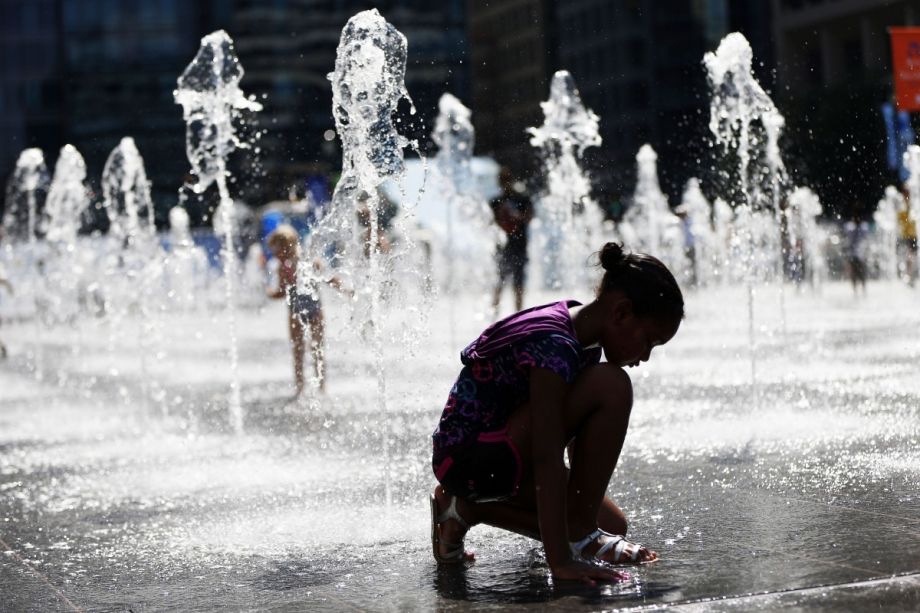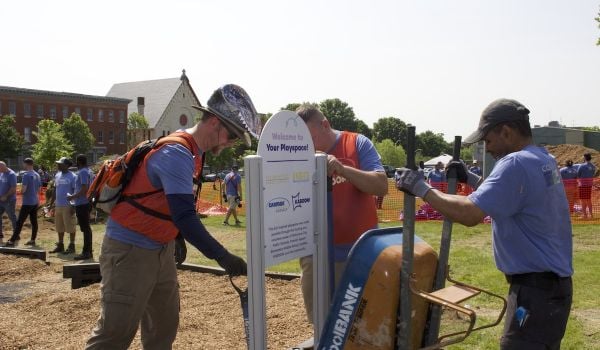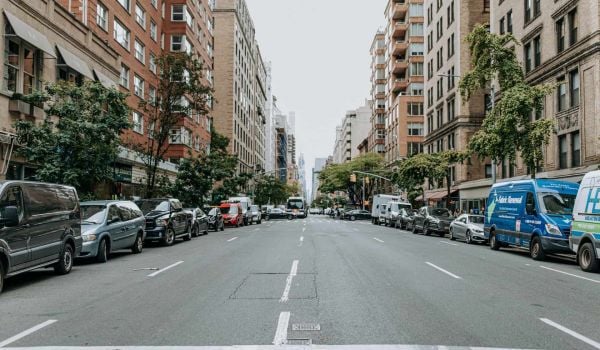Darell Hammond builds playgrounds. From spiral slides to mini rock walls and giant games of tic-tac-toe, his non-profit KaBOOM! is known for its thousands of community-centric parks. But as childhood screen time and obesity rates rise, he’s been forced to ask an odd question about his kid-friendly structures. In Hammond’s words: “What if kids aren’t playing on them?” What if building big, beautiful playgrounds isn’t enough?
A new report released today, “Using Behavioral Economics to Create Playable Cities,” by the non-profit suggests a fascinating alternative. Instead of setting spaces aside for play, why not integrate them into the streets, sidewalks and bus stops people use every day? If the park isn’t a destination — if it’s a bus stop in the shape of the word BUS that kids can lounge, jump and slide on — then they end up playing during their daily commute. And quick-access structures integrated into city streets could both keep families from leaving for the suburbs and encourage them to bike, walk and take the bus instead of driving cars.
With its emphasis on righting “play deserts,” KaBOOM! is no stranger to the politics of park access. Like grocery stores, bike lanes and even crosswalks, play spaces tend to be one of the things that adds 20 years of life to wealthier zip codes, and don’t exist in poorer ones. But the report, conducted jointly with ideas42, delves into some of the psychological barriers that can also limit access, using a lens called “behavioral economics” to see “how people make decisions in a complex and textured world where details matter.” Using this approach to evaluate interviews, researchers drew out the decision, “I will take my kid to the park” like a slow-motion scene, allowing them to see every rapid-fire thought in high definition.
In this context, taking your kid to the park is actually a complicated process: Kid gets home, tells you she’s hungry and eats a snack. You start making dinner, consider going to the park, wonder if it’s worth interrupting chores to go to the park, get ready, pack a bag, find a sweater and put a sweater on.
“These actions are all potential behavioral ‘sticking points,’ or what we like to call ‘bottlenecks,’ starting with a step most of us are unaware of — just the consideration of the option to play,” the report states.
Which is where the “corner store” playground comes in. It can be as simple as hopscotch lines on the pavement or swings in a bus stop — little prompts that encourage children and remind busy adults, “turning moments of frustration or idle time into play with all its muscle- and brain-building benefits,” Hammond says.
The report is being presented at KaBOOM!’s Playful City USA Leader Summit in Chicago, which focuses this year on three intertwining themes: “Foster play everywhere,” “Make cities family friendly” and “create the corner store of play.”
For Hammond, these three themes go together because family-friendly infrastructure can help urban cores retain residents with children. Even very dense neighborhoods can create pocket parks or hopscotch lines. And these detail changes are not expensive. They can, and must, be done everywhere.
“They need to be equitably distributed,” he says, citing Washington, D.C.‘s ambitious new bike lane grid. Troublingly, that project doesn’t benefit everyone; there are “none in the ward with the lowest income or highest percentage of kids,” he says.
Questions of distribution aside, the walking and biking movement is actually an inspiration to Hammond, and he sees kid-friendly infrastructure complementing a transportation system that utilizes public — not private automobile — space. It has so far “not been really family or child focused” he says. But add play spaces to a mode of transit where you’re stopping to board a bus, walking and or can easily pull your bike over for 10 minutes, and likely, more parents would get out of their cars.
The small city of Bloomington, Indiana wants to do just this. Tasked with creating a “bold goal” for the Chicago summit, the city wants to encourage residents to use non-motorized transportation 80 percent of the time. By 2016, it wants to be a platinum-certified bike-friendly city. And one way it plans to encourage families to cycle and walk is by creating “opportunities for play” along the way.
Senior Transportation Planner Anna Dragovich says that details are still nascent; she’s not sure what this kid-friendly infrastructure will look like. But the concepts of car-free travel and play inherently complement each other, she says.
“One of the barriers to play is lack of time,” she says. “We want to incorporate it in a way that doesn’t feel like playing. We’re asking how play can be a practical thing in the context of walking or biking to school, so that it’s purposeful.”
“Obviously we still want to see playgrounds being relevant,” Hammond says. The destination playground is great for how it’s already being used: a special outing. But kids need to play more in the context of their daily lives. And parents, bogged down in all their utilitarian tasks, need little prompts to help them remember. No place would be better than their daily route.
Join our conversation about building a more family-friendly Philadelphia on October 29 at Moore College of Art and Design.The Works is made possible with the support of the Surdna Foundation.

Rachel Dovey is an award-winning freelance writer and former USC Annenberg fellow living at the northern tip of California’s Bay Area. She writes about infrastructure, water and climate change and has been published by Bust, Wired, Paste, SF Weekly, the East Bay Express and the North Bay Bohemian
Follow Rachel .(JavaScript must be enabled to view this email address)

















